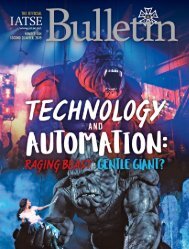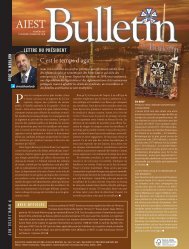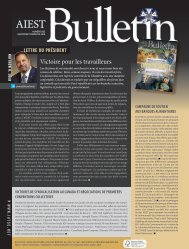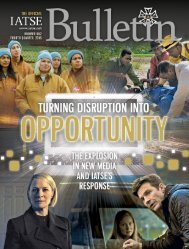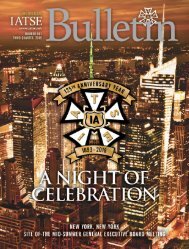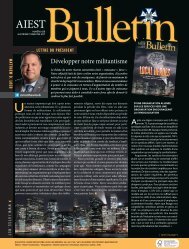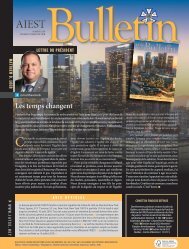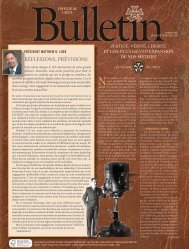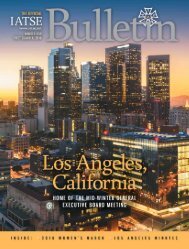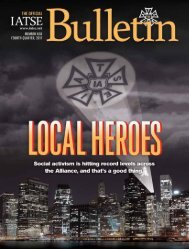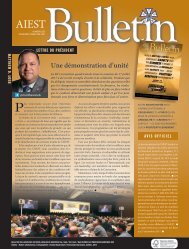IATSE-2nd2018_web
You also want an ePaper? Increase the reach of your titles
YUMPU automatically turns print PDFs into web optimized ePapers that Google loves.
GROWING PAINS<br />
After World War I, the decline in demand for propaganda films was eventually more than made up for by the increase in<br />
entertainment motion pictures - especially in Los Angeles. The number of films produced in California skyrocketed from<br />
1,900 to more than 12,000. As productions moved west, the number of workers in motion picture production in New York<br />
and New Jersey declined by half between 1921 and 1927.<br />
The Alliance set a new goal for itself, to link the entire motion<br />
picture production industry — from the camera operators to the<br />
film labs all the way to the projection booth — under a single<br />
union label. It was a formidable task. Vigorous organizing efforts<br />
were often met with setbacks and frustration.<br />
Workers in several film labs in New York City wanted a thirtyfive<br />
percent wage increase, a 44-hour work week and union<br />
recognition. But after a two-week strike, management hired<br />
replacement workers for the 2,500 who had struck. All the strikers<br />
won was a half-hearted promise to bargain with the union over<br />
wages.<br />
This was minor compared to what was happening out West.<br />
The entire AFL Building and Construction Trades Department<br />
— Painters, Carpenters, Electricians and others — united<br />
against <strong>IATSE</strong>. The unions used the 1919 AFL Convention to<br />
put forth resolutions claiming that the Alliance was unfairly<br />
forcing workers to join the IA and to give up their dual cards in<br />
the construction unions. They called for the IA to return these<br />
workers to their “rightful” unions and to stop making agreements<br />
with producers to provide skilled craftspeople for this work.<br />
Fortunately, skillful maneuvering by IA delegates prevented the<br />
passage of these resolutions.<br />
But two years later, in 1921, the building trades dealt <strong>IATSE</strong><br />
a devastating blow. At that year’s AFL Convention, the building<br />
trades unions succeeded in forcing the Alliance to give up all<br />
studio work. The IBEW would now do all the installation work in<br />
connection with lighting, leaving IA members only the “operation<br />
of all lights and of all devices for electrical lighting and electrical<br />
effects as well as the operation of moving picture machines.”<br />
The Carpenters would take even more of <strong>IATSE</strong>’s work,<br />
leaving the Alliance representing only the property people and<br />
set decorators. Particularly galling was the ruling that Alliance<br />
carpenters could no longer make props out of wood or build<br />
miniature sets, work they had been doing in theater property<br />
shops for more than fifty years.<br />
This unfair and potentially devastating arrangement could<br />
not be allowed to stand.<br />
THE PRODUCERS POUNCE<br />
The producers took full advantage of union divisions.<br />
They demanded wage cuts of twelve percent and an increase<br />
in straight time from eight to ten hours a day. They said these<br />
demands were necessary in light of the decreased demand for<br />
motion picture production immediately following the end of<br />
World War I.<br />
They failed to mention the exorbitant salaries of stars (who<br />
earned over $1 million a year in 1921, the equivalent of $13<br />
million today 3 ) and producers ($100,000 a year). Ironically, a<br />
July 24, 1921 New York Times article noted that there were many<br />
reasons why movies cost so much, including temperamental<br />
stars and directors, payrolls padded with relatives, and vast sums<br />
spent on the trappings of stardom.<br />
3<br />
https://data.bls.gov/cgi-bin/cpicalc.pl?cost1=1000000&year1=192101&year2=201801<br />
23




